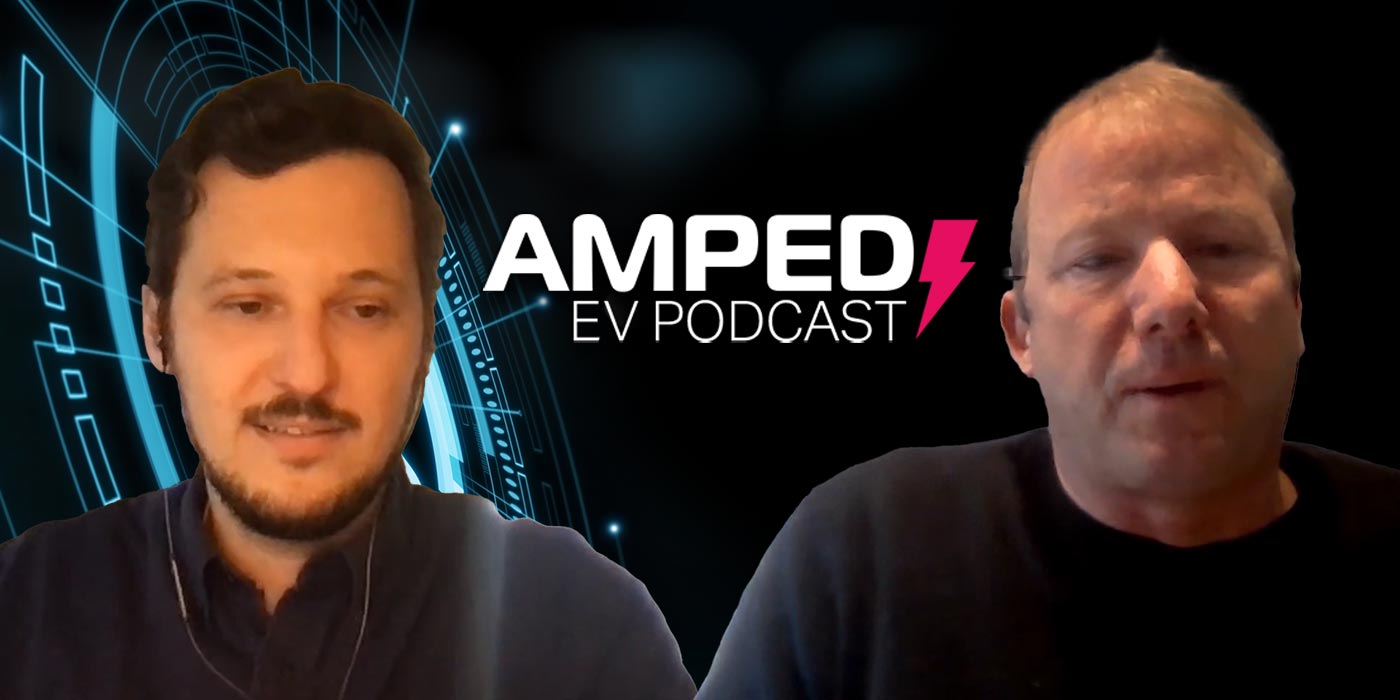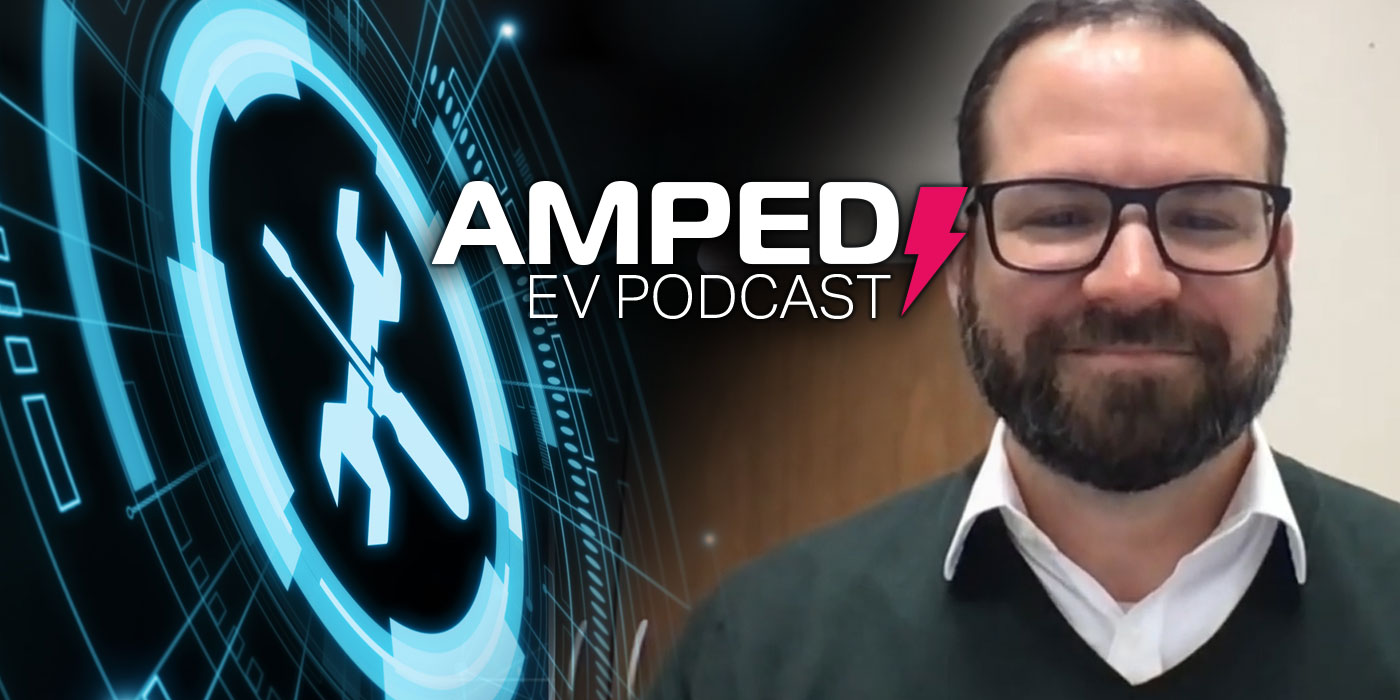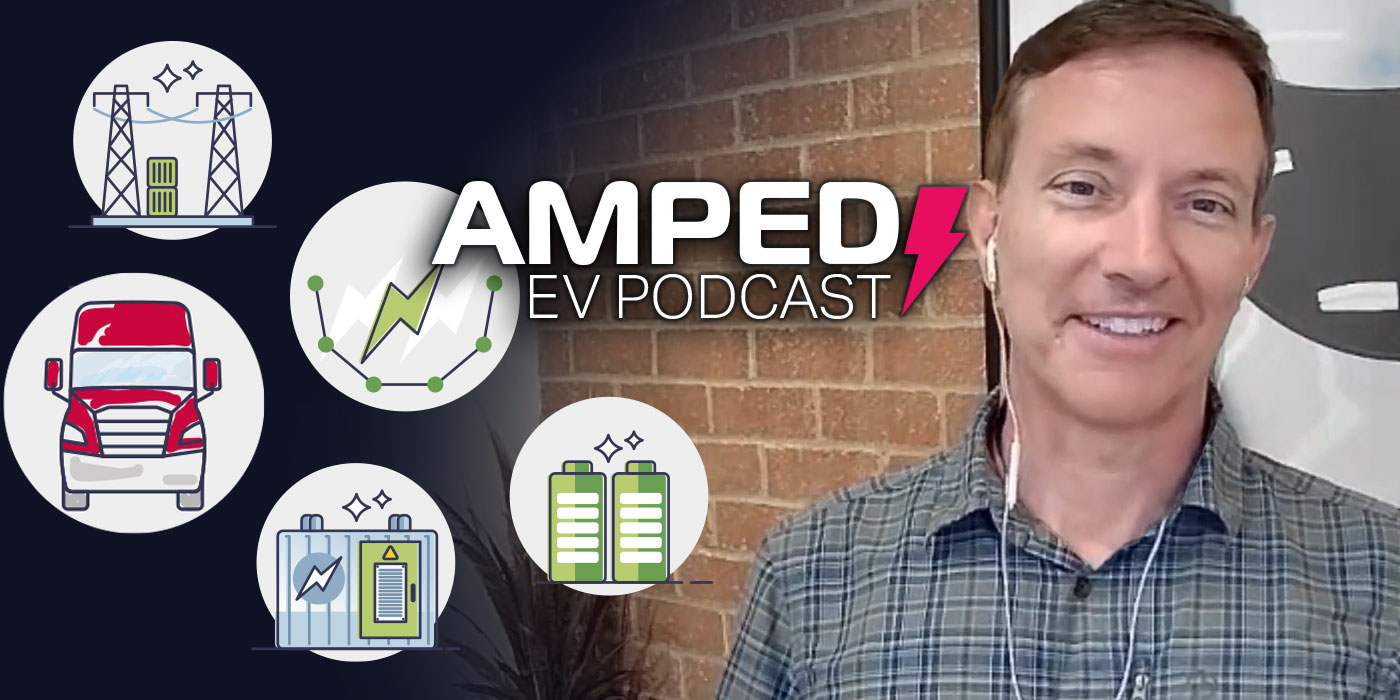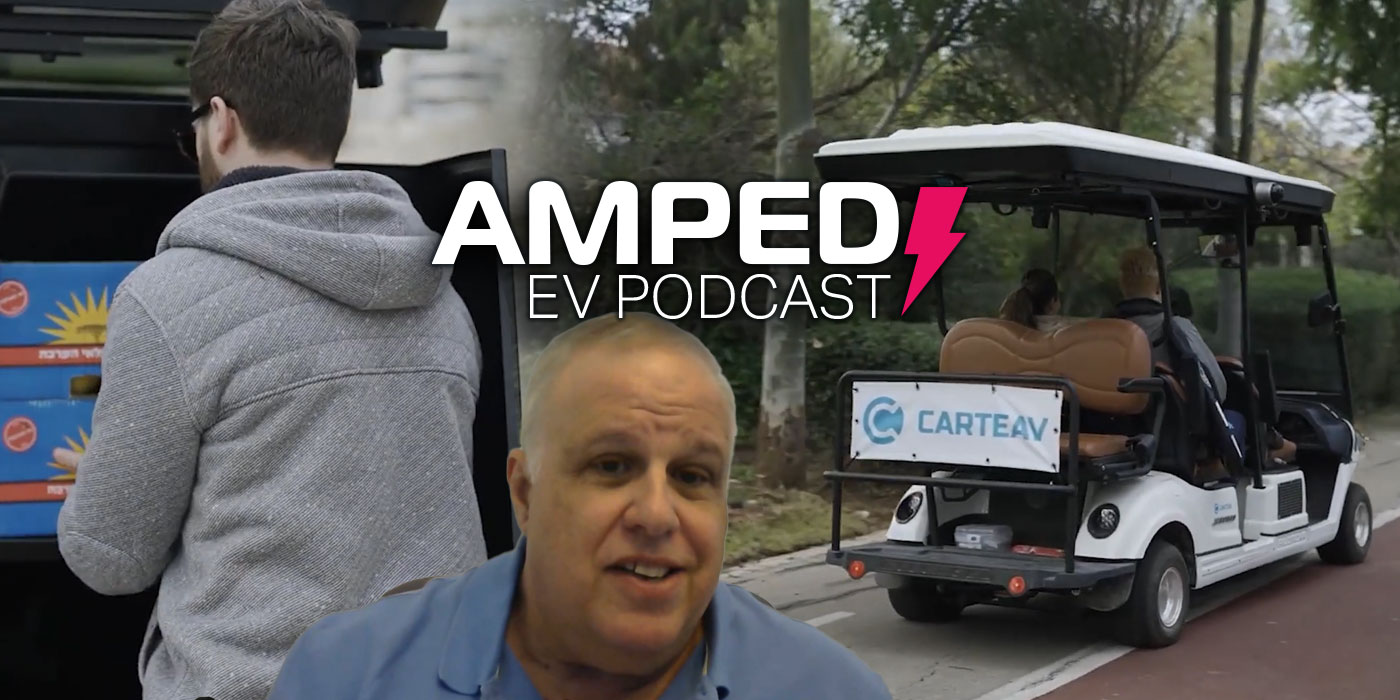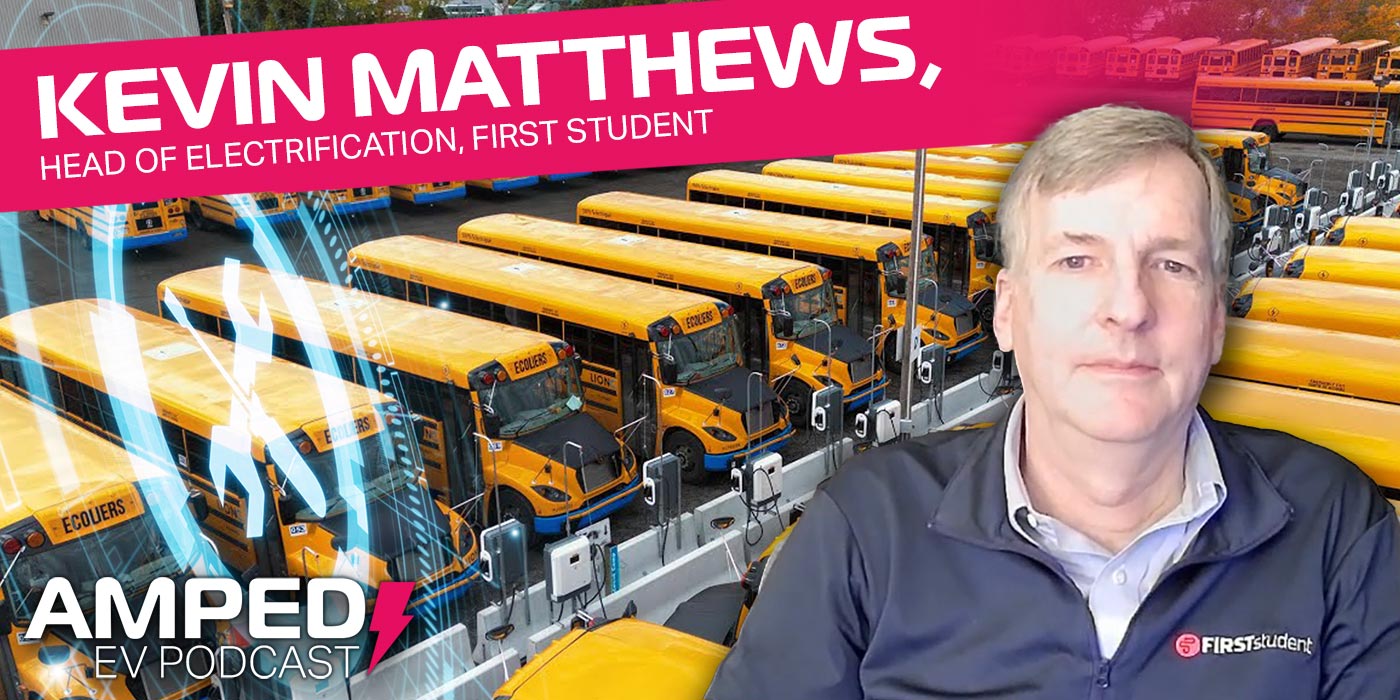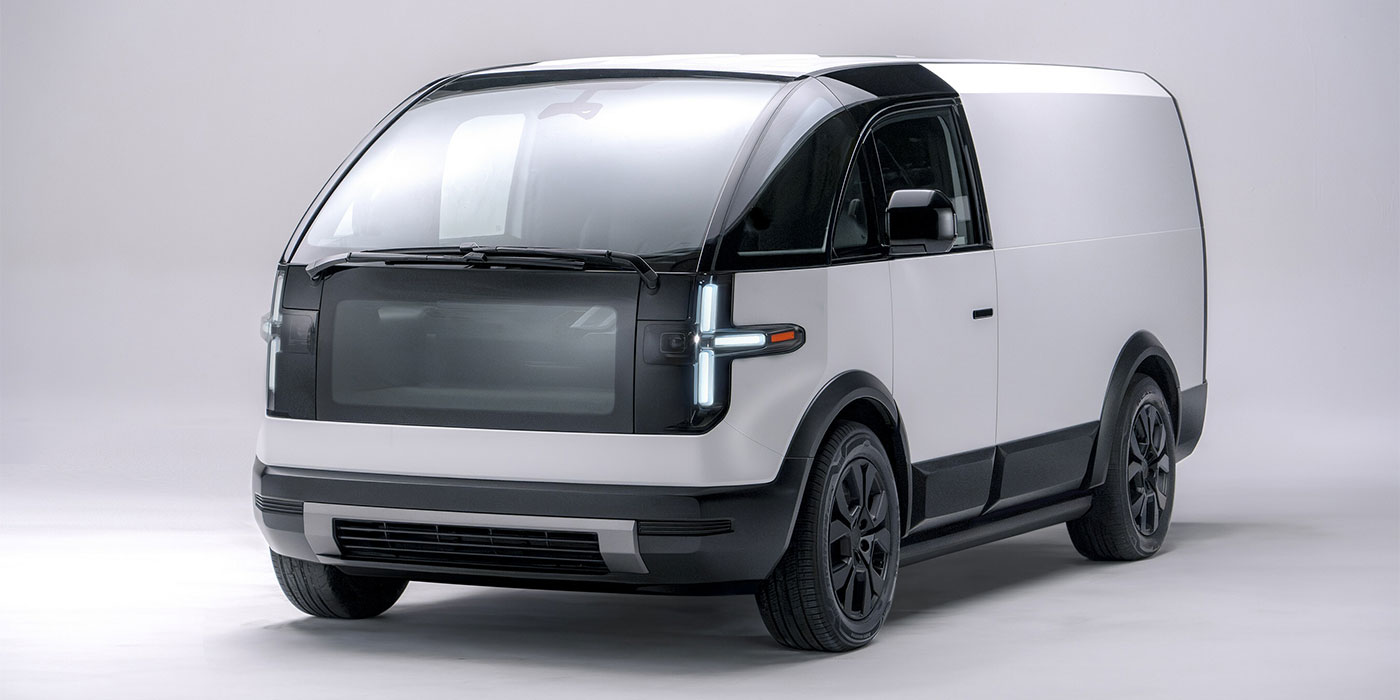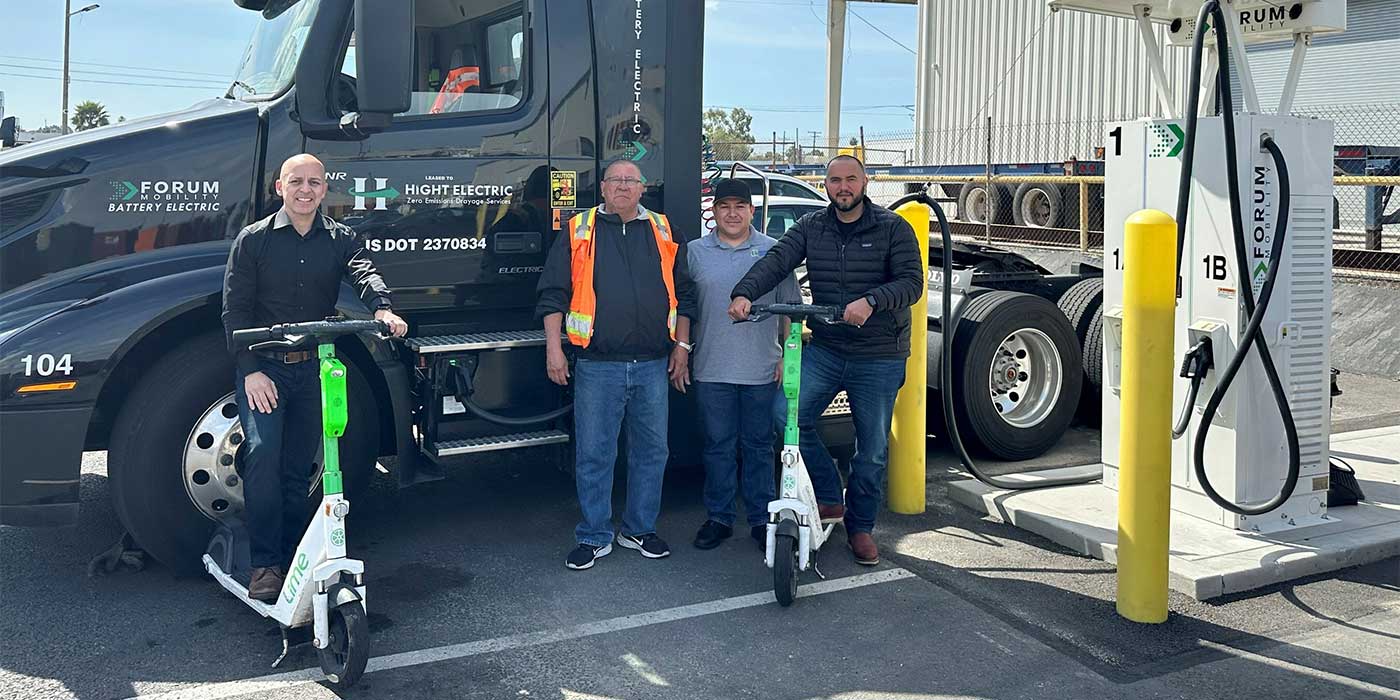Here’s the definitive truth: As the technology stands today, electric vehicles are a fantastic fit for some applications and not so great for others. Last-mile delivery, those routes that bring a product from the warehouse shelf to the customer’s doorstep, happens to fall into that first category. EVs fit in so well here because last-mile offers defined routes that can be planned to maximize the electric vehicle’s range and recharging opportunities.
We’ve already seen a few big names – including Walmart, FedEx and Amazon – jump into electrification with this application. So, now that electrification has had some time to mingle with last-mile, how are things going, and where do we see them headed? On today’s episode, we find out.
Want more Amped EV podcast? Click here.
Here’s a transcript of the show:
David Sickels: Hello, and welcome back to The Amped EV Podcast. My name is David Sickels. I am the editor for The Buzz.
Jason Morgan: I am Jason Morgan, content director for Fleet Equipment. Hey, David.
David Sickels: Hey, Jason.
Jason Morgan: What are we talking about today?
David Sickels: We’re talking about last-mile delivery and electrification.
Jason Morgan: Oh, okay. I like this topic.
David Sickels: Yeah, I thought it’d be a good topic. I feel like we’re always somewhere on both ends of the spectrum. It’s either consumer vehicles or heavy-duty semi-trucks. We never talk about what’s in the middle.
Jason Morgan: Right. No, I like the middle, and I mean, who doesn’t have these vans showing up every day to their house delivering stuff? Have you seen an electric one in real life yet?
David Sickels: I have.
Jason Morgan: Oh, wow.
David Sickels: Yeah, not at my house though. I live in Akron. We don’t have those.
Jason Morgan: Oh, where did you see it?
David Sickels: California.
Jason Morgan: Oh, you’re right, in California? That’s nice. Can I set the stage? I got something for you here.
David Sickels: Sure.
Jason Morgan: Just to set the stage. I know you said in the middle, I’m going to go a little higher. We’ll start at the top here and we’ll roll down the last mile hill. NACFE, continuing on their Run on Less Electric, their test of light to medium duty, to heavy-duty electric trucks, that we talked about earlier this year.
Jason Morgan: They’re still going through their treasure trove of data. They recently, over the past summer, announced that medium-duty box trucks are electrifiable. So we’re talking up to Class 6, 7, right? Which is maybe a little large for last mile, but you got to also consider stuff like beverage delivery, other larger commercial entities that are in the last mile regional delivery system.
Jason Morgan: They said that these were perfect. They estimate that a portion of the box truck market segment, about 380,000 trucks in the US and Canada are electrifiable, and will result in, I don’t know. I can’t read this number. There’s too many commas. We’ll put it on the screen. The number’s coming on the screen right now, a big number of metric ton of CO2 annually. It will save all that again.
Jason Morgan: Again, a lot of the last mile, same applications. They’re going to return home at the end of the day, right? They’re running around town. Again, I go back to a beverage distributor. You have a local point and then you’re running your beverage, whatever your beverage of choice is, or distributing there, kegs of yada, yada. Then you’re back at home night charging those trucks up for the next day and running them out.
Jason Morgan: One of the cool, and we’ve featured it on the show before, but just to call out one on the Run on Less Electric Program, Frito Lay ran a Class 6 Peterbilt with a Cummins electrified power train.
David Sickels: Oh, okay.
Jason Morgan: No Cummins engine, but Cummins battery, powering a power train with an electric motor.
David Sickels: And they’re running that now?
Jason Morgan: Well, so that was a test. I’ve got more on that.
David Sickels: Okay.
Jason Morgan: I’ve got more on that, actually, a lot more. I’ll probably give you a chance because I want to hear what you have going on here. But yeah, that was a prototype. Cummins is continuing to develop the battery electric. They developed, think of them as the, I keep saying, the brains and power, not unlike what they do in the ICE world. But they build the battery models, they integrate it all and then they create the software that makes it all possible.
David Sickels: Okay. You’re talking about prototype electric trucks and I feel like in this space, in this last mile space, prototypes are everywhere. I mean, they’re all over the place. I feel like every OEM is trying to make a prototype last-mile delivery truck. Because it is truly one of the most, I don’t want to say it’s a perfect application, but it’s one of the most viable, I feel like, for regular electric use.
Jason Morgan: Right.
David Sickels: We’re seeing Amazon and their partnership with Rivian.
Jason Morgan: Right.
David Sickels: We’ve got a BrightDrop with FedEx. BrightDrop is subsidiary company of General Motors.
Jason Morgan: Oh, okay.
David Sickels: They’re supplying FedEx with a bunch of electric trucks. I don’t know if you’ve heard of Canoo.
Jason Morgan: Yes.
David Sickels: But Canoo has these, it’s a very uniquely shaped little, it almost looks like a giant, if you were going to take a pill… but enormous. Like the size of a delivery truck.
Jason Morgan: Right.
David Sickels: They’re working with Walmart. And Walmart, I believe, I think they’re using 4,500 if I believe. And they’re contracted for 4,500, they could get a lot more.
Jason Morgan: 4,500 trucks or Canoo trucks?
David Sickels: Canoos.
Jason Morgan: Canoos.
David Sickels: Yes, Canoos.
Jason Morgan: Vans. I know what you’re talking about. It’s like a pod on wheels.
David Sickels: Absolutely. Yeah. We’ll show it here for sure. But it is a very, very unique, I mean, you’re going to know when this thing drives down the street. And, these are huge names, FedEx, Walmart, Amazon, these are some of the delivery behemoths in the U.S and they are all contracted to be running electric trucks within the next couple of years. And they’ve all been testing them. And obviously this is something that they’re investing heavily in. And it’s not going away. I mean, we’re going to see them coming down our street sooner or later, if you haven’t already.
Jason Morgan: Yeah. Well, and that’s an interesting point too, because I often wonder why haven’t I seen them already, even in the truck market, we’ve seen class eight electric trucks roll out and be available. You can buy them from a number of manufacturers right now. But the Class 6, 7 isn’t widely as widely available yet, which I don’t know. I just find interesting, because I feel like that application would hit that sweet spot.
Jason Morgan: I do think we’re poised to see more of them coming down the line. Even there’s a mix of new names and a mix of established names. I think even as you pointed out there, a lot of new names and a lot of established names. And a lot of people shifting over. Again, I know I had mentioned Cummins earlier. I did do a ride with them earlier and got to drive, their electric truck. I did a video, head over to fleetequipmentmag.com and check out that video. Sorry, I’m going to plug my own stuff. That’s why-
David Sickels: That’s really why we’re here.
Jason Morgan: I didn’t want to say it, but I’m glad you did. Anyway, Isuzu and Cummins are partnering to create a battery electric truck. This is building off a partnership they formed in 2019. And they recently announced over the summer that Cummins will integrate the Cummins power drive 6,000 into an Isuzu F-series truck, which I drove in that video. They really weren’t talking details. I don’t know if it’s the truck. I still think it’s a prototype, not a final build.
Jason Morgan: But Isuzu is looking to do more of this after this pilot phase, so they’re doing this pilot phase with Cummins. They’re seeing how this shapes up in the market. And they say that they are fully ready, commercialized, medium duty, kind of these last mile, medium duty trucks with Cummins battery power into the future following the pilots. So definitely positioned well to increase in the market.
David Sickels: So what was your takeaway, having the opportunity to drive that truck?
Jason Morgan: Yeah, I mean, like we’ve mentioned before, there are nuances between all the trucks, but they all feel very familiar too. I mean, when you hop into, like the Peterbilt cab four that we mentioned at the earlier part on the Run on Less, the 220EV Peterbilt, or you hop in the Isuzu, it still feels like those brand trucks. It still feels like a Peterbilt, still feels like an Isuzu, very similar there.
Jason Morgan: And then the electric power, it’s always so much fun to drive. I’ve gotten a chance to drive a couple. And like I’ve said before, where I see the differences the most, is in the regen braking. Because I continually suck at. Judging the regen braking and that’s one of the things that-
David Sickels: That’s not easy.
Jason Morgan: … Right, that’s one of the things that fleets on the commercial side when they’ll purchase these trucks, that’s tunable. So they can tune how much power the, it’s not the engine break, the regen break. From our world, it’s comparable to engine break. How much that kicks in, how much a driver feels it. Does it bring you down to a complete stop? Does it just bring you down to a crawl? Those differences are where I notice them.
Jason Morgan: Once the trucks are moving, and you’ve moved along, it’s wonderful. They’re quiet. A lot of the quality of the cab build starts to come to the forefront. You don’t have any of the vibration from it easily. You don’t have any of the noise from the diesel. So you can see how quiet cabs are. And you really take a notice of the driving environment more so, perhaps on electric than some of the diesel. You expect to hear the rumble of the diesel. You expect to feel some vibration. So when that goes away, you really start noticing the little stuff in the cabs that make a big difference.
David Sickels: And you know, were talking earlier about how they come home at night and they can recharge. And that’s all great. That’s all a great reason for these fleets to switch to electric. But the quietness of the vehicle is also another reason. I mean, that opens up times of day when they could be making deliveries that perhaps they couldn’t before, because a noise ordinance starts at 9:00 PM or something like that. Now all of a sudden they can go down those streets and continue to make those deliveries.
Jason Morgan: Right, and anecdotally, one thing I just thought of too, that we had talked about, or I had talked about with an OEM. Earlier last year though, but in some of these, this was for class eight, but I could see how it could make a difference here. Delivery times were faster, like noticeably faster because of the available torque at start.
David Sickels: Interesting.
Jason Morgan: Trucks were just going. And so in these applications where your start, stop, start, stop, start, stop all the time. That little, it might seem like a little microsecond, where you’re getting up the speed. But when in an EV, it happens like that. Add up all those, and it’s just that little bit of time compounds and you get faster delivery times.
David Sickels: You’re right. I wouldn’t think that would really make that much of a difference, but when you’re adding them all up over the course of a day and you bring that to a week or a month, all of a sudden you’re saving a lot of time.
Jason Morgan: Right. Well, and again, that was in class eight. So I’m speculating. So you can put up my usual, Jason Morgan disclaimer, speculating, yada yada. Yeah. It’s here somewhere. So yeah. I’m not held responsible for anything I say, that’s the wonderful part about those disclaimers.
David Sickels: That’s a takeaway, yeah.
Jason Morgan: But yeah. I mean, those things they’re nice, it’s enjoyable. So it was a wonderful drive looking forward to seeing how Cummins rolls out more of them. And just how more these roll into the market.
David Sickels: Sure. There’s other types of last mile vehicles as well. There’s this company, it’s called Biliti Electric.
Jason Morgan: Bility.
David Sickels: Yes. B-I-L-I-T-I.
David Sickels: And we’ve got this image of their last mile vehicle here. You can see, it’s almost like one of those scooters that you would see in somewhere, not the United States. We don’t have a lot of these types of vehicles here. This is an interesting one. Mainly, so first of all, range of 110 miles. So obviously they’ve got a pretty tight radius that these would be operating in. But the most interesting part I think, swappable batteries. That is this vehicle’s claim to fame. So-
Jason Morgan: Swappable.
David Sickels: … when they run out of juice, you take the battery out. You put a new one in and you go down the road. So you don’t have to spend any time charging.
Jason Morgan: Right.
David Sickels: It takes a minute.
Jason Morgan: Yeah, no, I’ve heard this and I’ve heard this theory come up a couple times. Where maybe at truck stops or other areas instead of refueling or in addition to charging stations, they would have these battery banks. So you’d go up, you’d put yours in. Kind of like a propane thing. When you’d take the propane, drop your propane off, get a new one.
David Sickels: Exactly. Yeah.
Jason Morgan: That’s how it works. That’s very cool.
David Sickels: Yeah, now I don’t see this working with large trucks anytime soon, but a vehicle like this one. I mean, if you’re delivering smaller packages and you’d not taking on a lot of weight, something like this might work in a tight radius. I don’t know. We might be seeing these too.
Jason Morgan: I do it with my lawnmower. I do it with… Yep. Pull that bad. I know it’s not the same. But the lawnmower is delivering me-
David Sickels: No, but it’s a good example of how the system works.
Jason Morgan: … Yeah, put a battery in, bring a battery out. Yeah. I mean, they’re serious batteries, right?
David Sickels: For sure.
Jason Morgan: I bet it would be the same thing on the scooter.
David Sickels: Absolutely.
Jason Morgan: But that’s very cool.
David Sickels: Another thing, and it’s actually not exactly a scooter, it’s a three Wheeler, but, I don’t know really, three Wheeler-
Jason Morgan: I don’t know.
David Sickels: … Officially, I’m not sure.
Jason Morgan: Trike.
David Sickels: Electric trike. Another thing that I wanted to bring up to, Goodyear, obviously one of the largest tire companies in the world. They in March announced that they had created a last-mile delivery EV tire. So not only is it for electric vehicles, which there aren’t a lot of tires out for those types of vehicles at this time, it’s specifically for the last mile segment of vehicle that are electrified.
Jason Morgan: So sorry, I’m going to out you right now.
David Sickels: Go ahead.
Jason Morgan: I’m going to out you. Now, your claim the fame is editor of The Buzz, but you do, we have a sister publication called, Tire Review.
David Sickels: Yes.
Jason Morgan: That you do also help out on. And you are a man of renowned in the tire industry. You know what’s going on with tires, I feel.
David Sickels: I’m a tire man.
Jason Morgan: That’s right. So tell me, is that the real deal? Is it marketing? Is it actually tires designed for these EVs and segment? How does that work?
David Sickels: So, it’s definitely designed for that segment and for those types of vehicles.
Jason Morgan: I see.
David Sickels: That being said, there is a little marketing twist. Because you could use and part of their actual, their messaging with this tire, it’s not so specific that you couldn’t use this tire for other applications as well, or an ICE vehicle, for example. So they’re really, it’s not so pinpointed and focused that’s the only use for it. But, it’s just interesting that, even if it only was marketing, if it was strictly marketing, isn’t it interesting that they are investing those dollars to tell you, “Hey, this is for this application, that is a growing segment.”
Jason Morgan: Yeah, well, and it also speaks to how some of these smaller fleets… We were talking before the cameras started rolling. Just talking about generally how many drivers Amazon has.
David Sickels: Yes.
Jason Morgan: Like we don’t know. No one knows. Because they have so many contractors. And when you’re a private business owning your own vehicle, the support you need on the tire side, you need that commercial level support. You need more than just your consumer level. You roll into the tire shop to get your tires replaced and move on, right?
David Sickels: Right.
Jason Morgan: So even if the compounding specific to electric vehicles that have more torque and maybe you need a little better compound where you’re getting rolling, so you don’t have any potential wear issues or even if you’re in last mile applications, it would even indicate that, hey Goodyear is there for you on a commercial level. It’s a commercial product for a commercial application, regardless of your size. You could have 10 vans, you could have 20 vans. You could have one van that’ll be running around the neighborhood like we all see every day. So yeah, they’re serving that market. That’s poised for growth for sure.
David Sickels: Yeah. Most definitely. I mean really my point with that is that there are very large, well known companies that are creating components for not just EVs, for last-mile delivery EVs. I mean, you think that such a specific segment, but when you start, the Amazons, the Walmarts, these huge corporations investing so much in these new electric vehicles. It’s not as niche as you think it is.
Jason Morgan: Right. Well, and in regard to that too, one of the things that I’ll tease here and that maybe I’ll bring back some info on, is that here in September NTEA Commercial Vehicle Upfitting event, it’s in our backyard, they’re having it at Kalahari up in Sandusky.
David Sickels: Wonderful.
Jason Morgan: So it’s about a 30-minute drive. I’m going to head up there, check it out in September. Going to meet up with some friends from Lion because they’re really pushing body-building upfit. So think about, yes, we have Amazon delivery vans, but you also see that Amazon delivery UPS size trucks, which would be a chassis that they put that body on top of.
Jason Morgan: And so as we get more into this last mile in regional delivery, yeah. I mean, you’ve got your power train and battery packs. It’s on a chassis or even in a van, when you look at something like the Ford Transit, there is a ton of upfitting support there to build whatever you need in the transit.
Jason Morgan: If it’s a HVAC, just had to buy a new furnace, so I’m familiar with this. But those kind of applications that they’re at a home base, you’re only running maybe 20, 30 miles here or there, you can charge it up. But the specific needs for the people that build the trucks on top of those chassis. They are custom built, they don’t often come right off a factory floor. Those chassis roll off. They go to the body builder that puts that on top of it or builds out the inside of it in case of a transit van.
Jason Morgan: So that is going to be a big, big talking point. And I feel like it’s something that had a presence. I mean, bodybuilding and Upfitting always had a presence to NTA, but the electric side of it. Having electric trucks and okay, we’re upfitting electric trucks. As you know those battery packs and modules are bolted to the frame rail in a lot of time. And that’s frame rail space you’re taking up that you could be using for other components. Right?
David Sickels: For sure.
Jason Morgan: So, should be super interesting to see how that pans out and develops. And I know Lion is putting a big push in there. I’ve been talking with them about stuff they’re going to have at the show. So we got that coming up here really soon.
David Sickels: Yeah. Definitely looking forward to talking to you about that. I want to leave you with a question here that I don’t really know the answer to. Maybe you can give us some insight. We started off this show talking about, there are all these vehicles out there, these last mile vehicles. But I haven’t seen them here in Akron. Why is that, why haven’t I seen them yet, what’s wrong?
Jason Morgan: Well, what’s our favorite topic to talk about here?
David Sickels: Infrastructure.
Jason Morgan: Infrastructure curses. Yeah. Infrastructure. So again, not to plug fleet equipment stuff but, I’m something I’m amped about. I love that thing. So we had the inflation reduction act, just pass here recently. There are huge tax incentives and credits for putting in infrastructure, 30% with some caveats. I won’t go into details here. There are some caveats there, but for commercial charging infrastructure, 30% tax incentive.
Jason Morgan: I guess I will say, the caveat is ‘in rural or low-income areas’ so I mean, that’s a stigma point. But there’s also a 30% tax credit for commercial vehicles. So I think that as we’ve discussed here, lots of times, it’s a big investment, to get this thing rolling. And so now looking at what’s coming down the line with the Inflation Reduction Act and all the support for EV infrastructure creation, EV purchases, I think it’s going to make a big impact.
Jason Morgan: I think within the next year or two, the world could look a lot different. I mean commercial is getting a lot of support. It’s way easier, than the passenger car stuff, which what we’ve all seen the headlines of, wow, the passenger cars don’t meet the requirements for all this things. Not in the commercial world, the commercial world does right now. And you can go buy it right now. So I think we will start seeing it, potentially, we’ll start seeing it before even you and I have an EV and get around to it. Because there’s a lot of back and forth and there’s a lot of support coming down the line, going into 23 with the Inflation Reduction Act.
David Sickels: And in our last episode, we talked with Lew Cox from MD7. He goes into a lot of this infrastructure, all these infrastructure needs and explaining what to do. I highly recommend that episode. I’ve learned a lot. It’s actually really interesting, but he’s talking about the fiber optic cable and needing that and the incentives that you might be able to get if you do own a business or if you’re in the commercial space and be able to do that. So there’s a lot of information there as well. I think that’s it from me, Jason.
Jason Morgan: It was a lot. And it was the first time we talked about the last mile, but not the last.
David Sickels: Oh, oh, I like what you did there. Okay.
Jason Morgan: Yeah.
David Sickels: We’ll put it on the calendar.
Jason Morgan: Okay. Yeah.
David Sickels: Okay. Hey, thanks for watching everybody.






